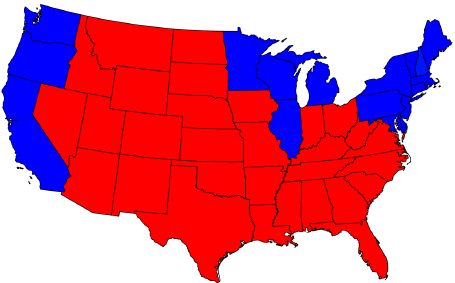
[Correction: The figures for numbers of counties voting Rep/Dem were off because of a bug in one of our programs. We've fixed this and corrected the text below. Thanks to K. Drum and others for pointing this out. (All the actual maps are perfectly fine however.)]
[Update: We've done some slight improvements to the cartograms, based on updated population and electoral data. (You'll have to look pretty hard to see any difference though.)]
[Update: We changed the color scale on the purple maps to be the same as that used by Robert Vanderbei. The old maps are still available at the very bottom of the page for those who are interested.]
[Wallpapers: By popular demand, the purple map and cartogram are now available in "wallpaper" sizes for your computer desktop. Click here.]
On election night and in the days since then, we have seen many maps that look like this (click on any of the maps for a larger picture):

We can correct for this by making use of a cartogram, a map in which the sizes of states have been rescaled according to their population. That is, states are drawn with a size proportional not to their sheer topographic acreage -- which has little to do with politics -- but to the number of their inhabitants, states with more people appearing larger than states with fewer, regardless of their actual area on the ground. Thus, on such a map, the state of Rhode Island, with its 1.1 million inhabitants, would appear about twice the size of Wyoming, which has half a million, even though Wyoming has 60 times the acreage of Rhode Island.
Here are the 2004 presidential election results on a population cartogram of this type:
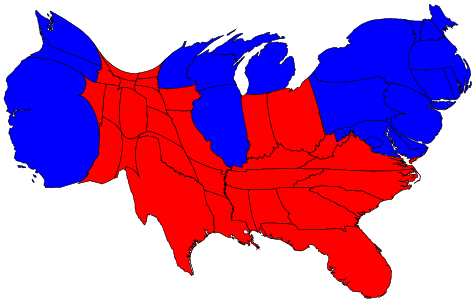
The cartogram reveals what we know already from the news: that the country was actually very evenly divided by the vote, rather than being dominated by one side or the other.
But we can go further. We can do the same thing also with the county-level election results and the images are even more striking. Here is a map of US counties, again colored red and blue to indicate Republican and Democratic majorities respectively:
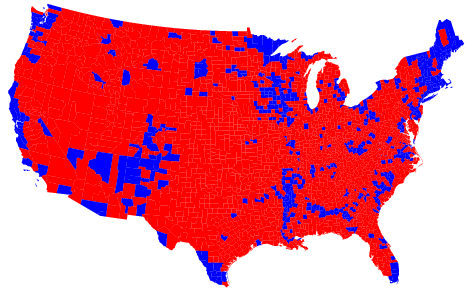
Similar maps have appeared in the press, for example in USA Today, and have been cited as evidence that the Republican party has wide support. Again, however, a cartogram gives a more accurate picture. Here is what the cartogram looks like for the county-level election returns:
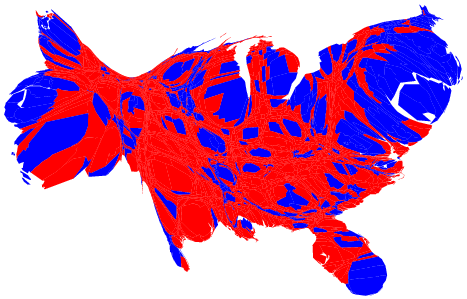
Again, the blue areas are much magnified, and areas of blue and red are now nearly equal. However, there is in fact still more red than blue on this map, even after allowing for population sizes. Of course, we know that nationwide the percentages of voters voting for either candidate were almost identical, so what is going on here?
The answer seems to be that the amount of red on the map is skewed because there are a lot of counties in which only a slim majority voted Republican. One possible way to allow for this, suggested by Robert Vanderbei at Princeton University, is to use not just two colors on the map, red and blue, but instead to use red, blue, and shades of purple to indicate percentages of voters. Here is what the normal map looks like if you do this:
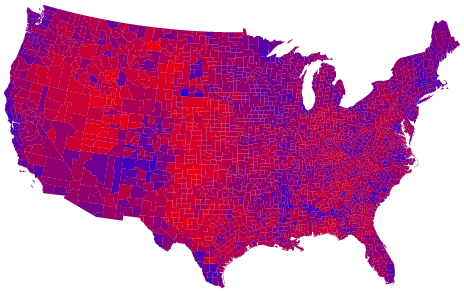
And here's what the cartogram looks like:
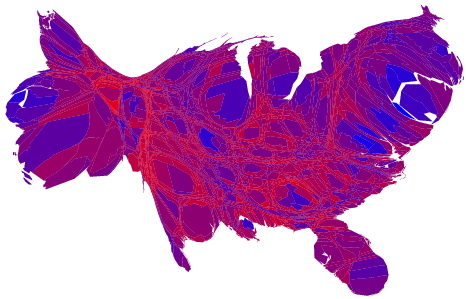
In this map, it appears that only a rather small area is taken up by true red counties, the rest being mostly shades of purple with patches of blue in the urban areas.
A slight variation on the same idea is to use a nonlinear color scale like this:
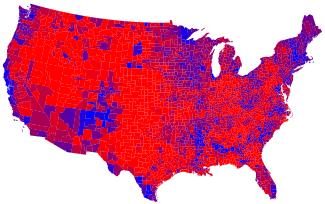
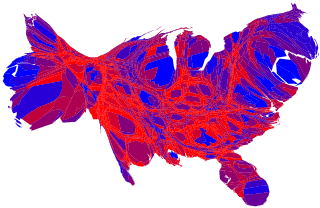
These maps use a color scale that ranges from red for 70% Republican or more, to blue for 70% Democrat or more. This is sort of practical, since there aren't many counties outside that range anyway, but to some extent it also obscures the true balance of red and blue.
© 2004 M. T. Gastner, C. R. Shalizi, and M. E. J. Newman

High-resolution versions of the figures appearing here are available on request from the authors.
Our computer software to produce cartograms is freely available here.
The views expressed are personal and are not necessarily shared by the University of Michigan.
Cosma Shalizi, Center for the Study of Complex Systems, University of Michigan. Updated: November 9, 2004